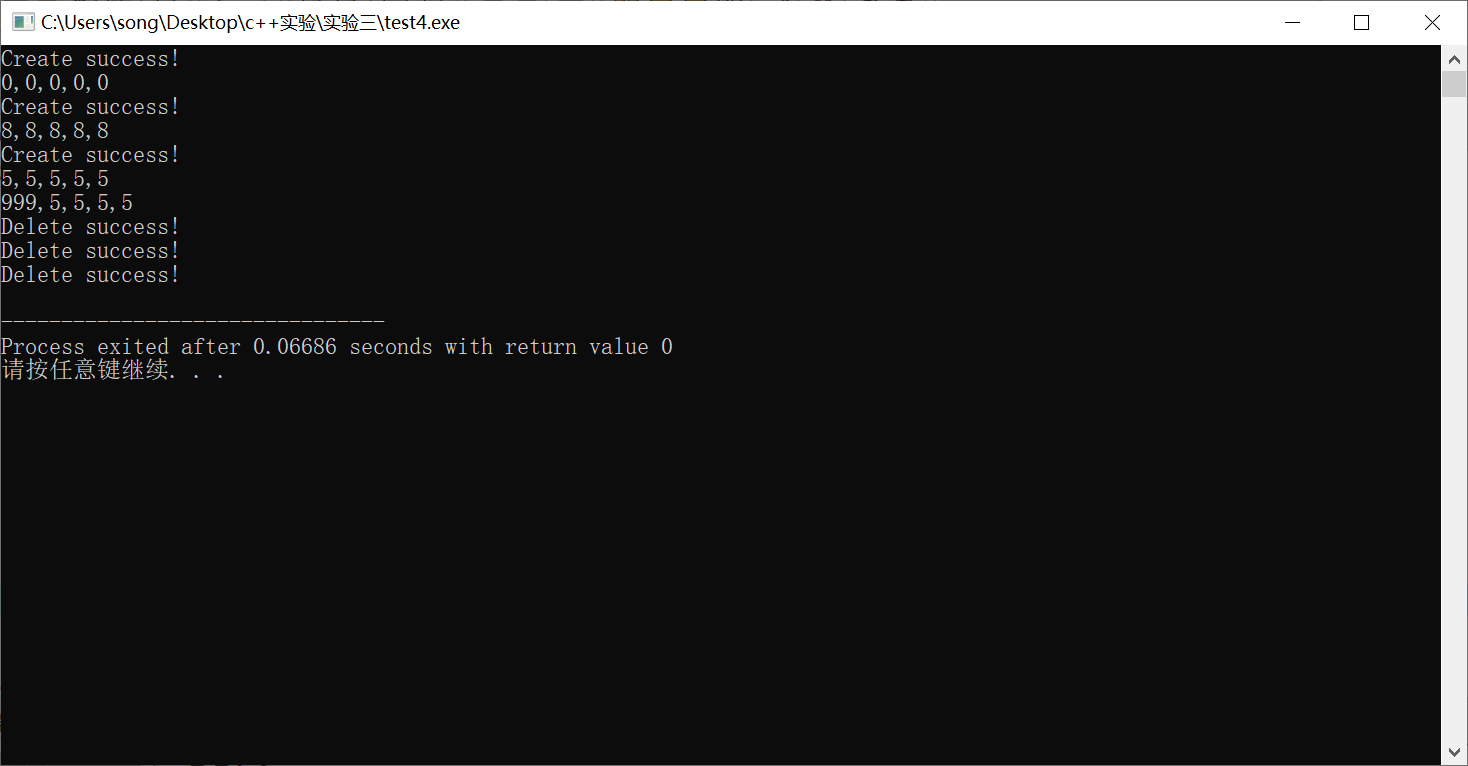实验3 类和对象Ⅱ
一、实验结论
1.实验任务4
#ifndef VECTOR_INT_HPP #define VECTOR_INT_HPP #include <iostream> using namespace std; class Vector_int{ public: Vector_int(int nn,int v=0); Vector_int(Vector_int &vec); int &at(int x); void print(); ~Vector_int(); private: int n,value; int *p; }; Vector_int::Vector_int(int nn,int v){ n=nn; value=v; p = new int[n]; for(int i=0;i<n;i++){ p[i] = value; } cout << "Create success!" << endl; } Vector_int::Vector_int(Vector_int &vec){ n=vec.n; value=vec.n; p = new int[n]; for(int i=0;i<n;i++){ p[i] = value; } cout << "Create success!" << endl; } int &Vector_int::at(int x){ return p[x]; } void Vector_int::print(){ for(int i=0;i<n;i++){ cout << p[i]; if(i!=n-1){ cout << ","; }else{ cout << endl; } } return; } Vector_int::~Vector_int(){ delete[] p; cout << "Delete success!" << endl; } #endif
#include "Vector_int.hpp" #include <iostream> int main(){ using namespace std; Vector_int x1(5); x1.print(); Vector_int x2(5,8); x2.print(); Vector_int y(x2); y.print(); y.at(0) = 999; y.print(); return 0; }

2.实验任务5
#ifndef MATRIX_HPP
#define MATRIX_HPP
#include <iostream>
using namespace std;
class Matrix
{
public:
Matrix(int n); // 构造函数,构造一个n*n的矩阵
Matrix(int n, int m); // 构造函数,构造一个n*m的矩阵
Matrix(const Matrix &X); // 复制构造函数,使用已有的矩阵X构造
~Matrix(); //析构函数
void set(const double *pvalue); // 用pvalue指向的连续内存块数据为矩阵赋值
void set(int i, int j, int value); //设置矩阵第i行第j列元素值为value
double &at(int i, int j); //返回矩阵第i行第j列元素的引用
double at(int i, int j) const; // 返回矩阵第i行第j列元素的值
int get_lines() const; //返回矩阵行数
int get_cols() const; //返回矩列数
void print() const; // 按行打印输出矩阵
private:
int lines; // 矩阵行数
int cols; // 矩阵列数
double *p; // 指向存放矩阵数据的内存块的首地址
};
Matrix::Matrix(int n){
lines = n;
cols = n;
p = new double[lines*cols];
}
Matrix::Matrix(int n,int m){
lines = n;
cols = m;
p = new double[lines*cols];
}
Matrix::Matrix(const Matrix &X){
lines = X.lines;
cols = X.cols;
p = new double[lines*cols];
for (int i = 0; i < lines * cols; i++) {
p[i] = X.p[i];
}
}
Matrix::~Matrix(){
delete[] p;
}
void Matrix::set(const double *pvalue){
for (int i = 0; i < lines * cols; i++) {
p[i] = pvalue[i];
}
}
void Matrix::set(int i, int j, int value) {
p[cols * i + j] = value;
}
double &Matrix::at(int i, int j) {
return p[cols * i + j];
}
double Matrix::at(int i, int j) const {
return p[cols * i + j];
}
int Matrix::get_lines() const {
return lines;
}
int Matrix::get_cols() const {
return cols;
}
void Matrix::print() const {
int flag = 0;
for (int i = 0; i < lines * cols; i++) {
if (flag != 0 && flag % cols == 0)cout << endl;
cout << p[i] << ' ';
flag++;
}
cout << endl;
}
#endif
#include <iostream> #include "matrix.hpp" int main() { using namespace std; double x[] = {1, 2, 3, 4, 5, 6}; Matrix m1(3, 2); // 创建一个3×2的矩阵 m1.set(x); // 用一维数组x的值按行为矩阵m1赋值 m1.print(); // 打印矩阵m1的值 cout << "the first line is: " << endl; cout << m1.at(0, 0) << " " << m1.at(0, 1) << endl; cout << endl; Matrix m2(2, 3); m2.set(x); m2.print(); cout << "the first line is: " << endl; cout << m2.at(0, 0) << " " << m2.at(0, 1) << " " << m2.at(0, 2) << endl; cout << endl; Matrix m3(m2); m3.set(0, 0, 999); m3.print(); }

二、实验总结
1.释放内存非常重要;
2.查找资料后发现除了上面的方法外,二维数组的建立可以用两层指针来实现,似乎更加符合二维数组的几何结构。




 浙公网安备 33010602011771号
浙公网安备 33010602011771号